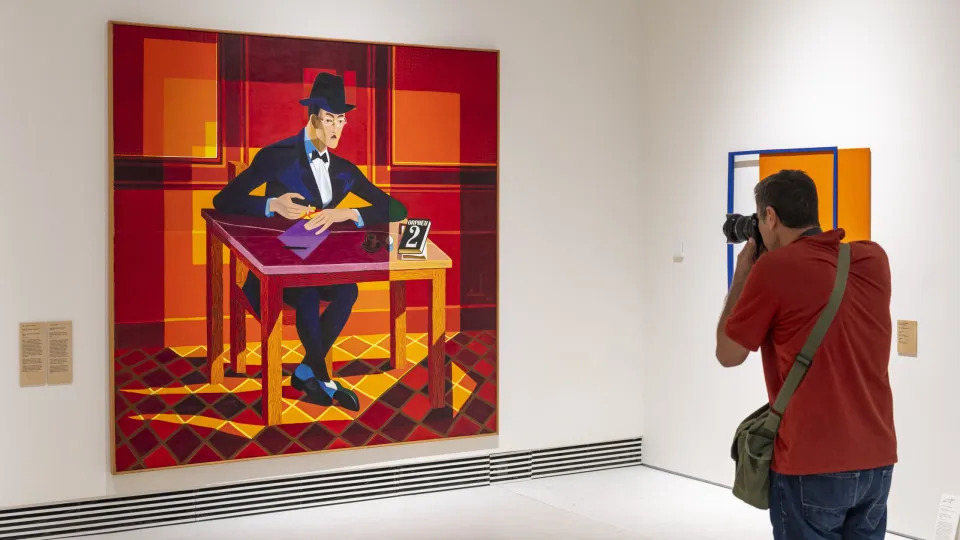
The new presentation of the CAM Collection at the Calouste Gulbenkian Foundation will open to the public on Saturday, featuring works by Franco-Algerian artist Zineb Sedira and a project by artist Francisco Trêpa.
During a press tour, the Gulbenkian announced that entry will be free for visitors up to 18 years old, aiming to encourage interest in art. This extends the previous free entry limit from 12 years at the museum.
Titled ‘Scheherazade, the Endless Collection of the CAM,’ this exhibition, curated by Leonor Nazaré, will remain open until September 20, 2027, at the Galeria da Coleção. The exhibition draws inspiration from the fictional tales of Persian origin ‘The Thousand and One Nights’ and its mythical narrator Scheherazade.
Artists represented in this selection of artworks include Álvaro Lapa, Maria Helena Vieira da Silva, Daniel Blaufuks, Paula Rego, Amadeo de Souza-Cardoso, Bernardo Marques, Julião Sarmento, Candido Portinari, Belén Uriel, Canto da Maya, Eduardo Nery, Fernando Lanhas, Ana Hatherly, Cruzeiro-Seixas, and Carla Filipe. The works span various formats, including painting, sculpture, photography, collage, installation, film, and books.
“The works in the CAM Collection have nothing to do with the stories of ‘The Thousand and One Nights,’ but Scheherazade inspired us as a fictional device to create a structure where one narrative opens into another, almost endlessly,” curator Leonor Nazaré explained during the visit.
The CAM was inaugurated in 1983, and the collection, growing since then, now comprises over 12,000 modern and contemporary artworks, with a strong focus on 20th and 21st-century Portuguese art, along with a notable collection of British art and other international artworks.
“What interested me was the narrative model, ideal for constructing an exhibition of the collection that won’t have an end as it will undergo successive changes, even at the architectural level, over its two-year duration,” indicated the curator, referencing the Persian queen who escaped death by narrating story after story, according to legend.
Leonor Nazaré summarized the ensemble in numbers: “About 150 artists for a total of around 160 works, eight of which are outside the gallery, four artist books from the Art Library, and two books from the Gulbenkian Museum collection, approximately 45 artworks from the first half of the 20th century, and a hundred from the second half, with 15 new acquisitions displayed for the first time, and 57 living artists represented.”
To present the selected works in a “legible” manner, the curator identified “14 facets across the entire collection of stories,” with “three major guiding principles” of the exhibition’s construction: “The seduction of words, language, and narrative, a technique used by Scheherazade, highlighting the importance of the book object; the intense struggle for survival, and a great diversity of works, including both mundane and extraordinary objects.”
For the first time, there will be an introductory text for children on some selected works, marked in the exhibition.
The exhibition allows the public to view a variety of art pieces, including a new sculptural work commissioned from artist Sara Bichão, paintings by Maria Helena da Silva like ‘The Library on Fire’ (1974), a portrait of Fernando Pessoa by Almada Negreiros (1964), an installation by Fernanda Fragateiro titled ‘(Not) reading the landscape #2’ (2010), or ‘Open Scene’ (1940) by António Dacosta.
Among new acquisitions never before displayed are a large painting by artist and singer-songwriter Manuel João Vieira titled ‘The Collector’ (1989), ‘Varina eating watermelon’ (1949) by Júlio Pomar (1926-2018), and ‘Ana#2’ (2024) by artist Leonor Antunes.
Benjamin Weil, in the introduction to the CAM visit, emphasized that the new season comes “a year after reopening following extensive renovation works,” presenting a new long-term exhibition in a modular project by architect Rita Albergaria that “follows a path of environmental sustainability, allowing for an evolving exhibition without needing to rebuild walls.”
He also highlighted the innovation of the project initiated at the Engawa Space, which will function “as an experimental lab,” where exhibitions and an artist’s workspace will be presented for the public to follow live.
The first exhibition, open until January 2026, is by Francisco Trêpa, featuring a constellation of ceramic sculptures resulting from a project that observes gall nuts in the CAM Garden.
This exhibition is part of Institution(ing)s, a European cooperation project co-funded by Creative Europe and coordinated by the Universidade Católica Portuguesa, based in the Engawa Space at CAM until 2028, in a consortium with seven other international institutions.
On the same day, CAM inaugurates, in the Project Space, a solo exhibition by Franco-Algerian artist Zineb Sedira, based in Paris and London, who has reflected on themes such as migration, history, and the partiality of narratives, using autobiographical, fictional, and documentary storytelling.
The original English title of the exhibition, ‘Standing Here Wondering Which Way to Go,’ cites a song performed by African American gospel singer Marion Williams at the Pan-African Festival in Algiers in 1969, a period of particular interest to the artist, especially regarding movements against racism and colonialism.
“From an early age, I was interested in the theme of art as a tool of denunciation and political and activist struggle,” stated Sedira during the exhibition tour, which encompasses multiple sections filled with photographs, posters, collages, and vinyl record covers showcasing iconic figures like Martin Luther King, Angela Davis, and Victor Jara.
With curation by Rita Fabiana, this project, commissioned by CAM, was realized in collaboration with the cultural center Jeu de Paume in Paris, the Modern Art Institute of Valencia, and the Bildmuseet in Umeå, Sweden, co-produced with the Tabakalera International Center for Contemporary Culture, San Sebastian, Spain.




